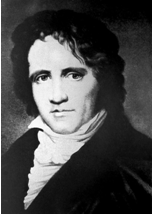- 1610: Galileo
- 1676: Ole Rømer
- 1687: Isaac Newton
- 1781: William Herschel
- 1838: Friedrich Bessel
- 1861: William and Margaret Huggins
- 1912: Henrietta Leavitt
- 1917 Einstein
- 1920: Harlow Shapley
- 1929 Edwin Hubble
- 1948: Ralph Alpher
- 1949: Fred Hoyle
- 1963: Maarten Schmidt
- 1964: Arno Penzias and Robert Wilson
- 1978: Vera Rubin and Kent Ford
- 1989: Margaret Geller and John Huchra
- 1992: John Mather and George Smoot
- 1995: Robert Williams
- 1998: Saul Perlmutter and Brian Schmidt
- 2010: Wendy Freedman
1838: Friedrich Bessel Measures Distance to a Star
 |
| Friedrich Wilhelm Bessel. |
The idea that Earth goes around the Sun, rather than the other way around, was proposed in 1543 by Nicholas Copernicus, but it was not confirmed by solid evidence for nearly 300 years. While other astronomers were working on the problem, the honor of being the first to publish an accurate distance to a star is usually credited to Friedrich Wilhelm Bessel Director of Königsberg Observatory in Prussia, (now Kaliningrad, Russia) who worked on the problem for 28 years, using the finest telescopes then available.
Skeptics of Copernicus’ idea argued that if Earth really did orbit the Sun, the closer stars would be seen to move in relation to the more distant stars as Earth traveled from one side of the Sun to the other. This is the same phenomenon that we see when we drive along a road, and notice that objects closer to the road seem to pass our view quickly, while those in the far distance appear to move more slowly. In the case of Earth circling the Sun once a year, closer stars should be seen to “jump” back and forth against background stars over six months. The amount of this “jump” is called the parallax of the star.
The skeptics were right in that observing such relative motions among the stars would be solid evidence that Earth moves, but it was a very difficult observation to make since all of the stars are so far away. The separation between two stars is measured in degrees. Since there are 360° (degrees) in a circle, the separation between a star overhead and one on the horizon is 90°. The width of the moon is about 0.5° or one half of one degree. The separation that Bessel had to measure between the stars in the field of his telescope was only 0.00001742° or less than two hundred thousandths of a degree—comparable to the width of a pizza in New York as observed from San Francisco! In order to make such a precise measurement, Bessel used a split image telescope.
This tiny back-and-forth movement of the star 61 Cygni in comparison with background stars reported by Bessel in 1838 corresponded to a distance from Earth of 11.4 light years, a value very close to modern measurements. At the time it was considered a staggering distance. Since it was already known that it took light from the Sun about 8 minutes to travel the 93 million miles to Earth, the idea that it took light 11.4 years to travel to Earth suggested an almost incomprehensible distance—and that was just one of the close stars! The term "parsec" is often used in science fiction novels and movies (sometimes incorrectly as a unit of time, like in Star Wars). Parallax angles were once synonymous with distance and therefore a "parallactic second", or parsec, became a unit of distance. This is similar to how redshift has become synonymous with distance and look-back time.